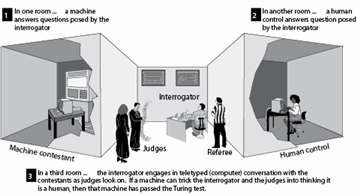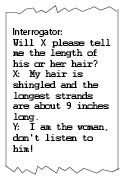| Yes: human imitation is sufficient Position1 #297 The orginal Turing Test is an imitation game in 2 stages: 1) a man and a woman each try to convince an iterrogator that he or she is a woman; 2) the man is replaced by a machine. If the machine successfully imitates the man, it can think. |
Alan Turing 1950.  
The Turing Test is introduced by way of an imitation game, where a man tries to imitate a woman via teletype. "The Imitation Game
I propose to consider the question, 'Can machines think?' This should begin with definitions of the meaning of the terms 'machine' and 'think'. The definitions might be framed so as to reflect so far as possible the normal use of the words, but this attitude is dangerous. If the meaning of the words 'machine' and 'think' are to be found by examining how they are commonly used it is difficult to escape the conclusion that the meaning and the answer to the question, 'Can machines think?' is to be sought in a statistical survey such as a Gallup poll. But this is absurd."
The First Game—Man or Woman?
"Instead of attempting such a definition I shall replace the question by another, which is closely related to it and is expressed in relatively unambiguous words. C: Will X please tell me the length of his or her hair? Now suppose X is actually A, then A must answer. It is A's object in the game to try and cause C to make the wrong identification. His answer might therefore be: 'My hair is shingled, and the longest strands are about nine inches long.' "
"In order that tones of voice may not help the interrogator the answers should be written, or better still, typewritten. The ideal arrangement is to have a teleprinter communicating between the two rooms. Alternatively the question and answers can be repeated by an intermediary.
The object of the game for the third player (B) is to help the interrogator. The best strategy for her is probably to give truthful answers. She can add such things as 'I am the woman, don't listen to him!" to her answers, but it will avail nothing as the man can make similar remarks. We now ask the question, 'What will happen when a machine takes the part of A in this game?' Will the interrogator decide wrongly as often when the game is played like this as he does when the game is played between a man and a woman?"
The Second Game—Machine or Human?
These questions replace our original, 'Can machines think?'
2. Critique of the New Problem
As well as asking, 'What is the answer to this new form of the question?' one may ask, 'Is this new question a worthy one to investigate?' This latter question we investigate without further ado, thereby cutting short an infinite regress. The new problem has the advantage of drawing a fairly sharp line between the physical and the intellectual capacities of a man. No engineer or chemist claims to be able to produce a material which is indistinguishable from the human skin. It is possible that at some time this might be done, but even supposing this invention available we should feel there was little point in trying to make a 'thinking machine' more human by dressing it up in such artificial flesh. The form in which we have set the problem reflects this fact in the condition which prevents the interrogator from seeing or touching the other competitors, or hearing their voices."Source: Turing, A.M. (1950) "Computing Machinery and Intelligence" in Boden. M. ed. The Philosophy of Artificial Intelligence. Oxford: Oxford University Press. |